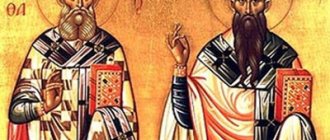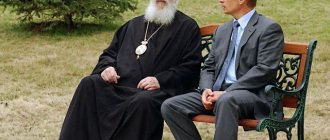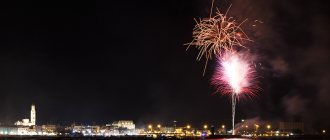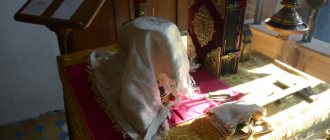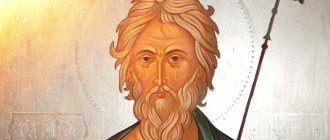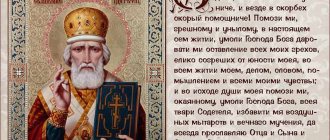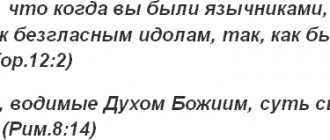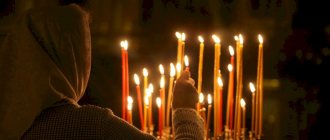Saints
- a host of saints from the episcopal rank, revered by the church as heads of individual church communities, who, with their holy lives and righteous shepherding, fulfilled God’s providence for the Church in its movement towards the Kingdom of Heaven.
The bishop reveals to his Church the image of God, symbolizing Christ during the Eucharistic celebration and leading the community in all its spiritual life. St. Ignatius of Antioch (d. c. 107) likens bishops to Christ, and the elders who help him in governing the church to the apostles. At the same time, the bishop unites the church community within himself and stands before God for it. As St. Cyprian of Carthage (d. 258) wrote, “the bishop is in the Church, and the Church is in the bishop.”
The holiness of the saints as primates of the church (subject to a blameless life and righteous death) is, first of all, an expression of the holiness of the Church itself as the Body of Christ. Being intercessors before God for their flock during life, bishops remain so even after death. Bishops receive the gift of teaching (see Tit. 1.9) and continue their apostolic ministry; apostolic succession serves as an expression of their continuous connection with the apostles - the ordination of bishops has been carried out continuously since apostolic times, when the apostles appointed the first bishops. Accordingly, the veneration of the saints is in a continual relationship with the veneration of the apostles.
Initially, the veneration of bishops was concentrated in local churches; each local community honored and celebrated the memory of all its primates (bishops) from the time of its founding (except, of course, those who fell into heresy or otherwise found themselves unworthy). The names of bishops were included in diptychs and were regularly remembered during services. Sozomen in his Church History (c.) also speaks of the annual honoring of the memory of saints as an established practice; just like the martyrs, their memory was celebrated on the days of their repose. As the church-wide cult of individual saints developed, the veneration of the saints outgrew the boundaries of their dioceses and became church-wide. This was facilitated by the formation of a hierarchical structure of church jurisdiction (patriarchate, archdiocese, metropolitanate), when the primates of the older churches were revered by the entire church region. Thus, among the saints all the Roman popes of the first centuries of Christianity are revered, almost all the patriarchs of Constantinople, starting with Mitrophan (315-325 reign) and up to Eustathius (1019-1025 reign), except for those who fell into heresy, left the department or led unworthy life.
Subsequently, significant selectivity appeared in the canonization of bishops, and this testifies to a certain change in the concept of saintly holiness: the emphasis is transferred from righteous shepherding to the personal asceticism of the bishop and his role in the organization of church life. This change in concept was apparently due to the spread of universal veneration to the saints, when only certain locally venerated bishops are among the saints venerated by the entire church (which implies selectivity).
There is a novella by Emperor Leo the Wise (886-911 reign), in which it is prescribed that throughout the entire Greek Church, along with the apostles and martyrs, the memory of the seven most famous saints should be celebrated: Athanasius of Alexandria, Basil the Great, Gregory the Theologian, Gregory of Nyssa, John Chrysostom , Cyril of Alexandria and Epiphanius of Cyprus. One must think that this decree consolidated an already established practice, and this shows that selectivity was already inherent in it.
In the Russian Church, selectivity in the veneration of saints has taken place from the very beginning. The first Russian saint to whom veneration is established is Saint Leonty, the third bishop of Rostov (+ c. 1070/1073/1077). The celebration of his memory was first held in Rostov in 1190 on the day of the discovery of his relics (May 23); It is characteristic that the relics of his successor Isaiah were discovered at the same time, but veneration of his memory was not established; selectivity in this case was due to the miracles that took place at the tomb of St. Leontia. Among the earliest canonized saints, whose veneration arose soon after their death, are the Moscow Metropolitans Peter, Alexy and Jonah, St. Stefan Permsky.
In honor of the saints, the fourth particle is taken out of the “nine-time” prosphora. In the Russian rite of proskomedia they remember: “Who are our holy fathers, the saints: Basil the Great, Gregory the Theologian and John Chrysostom; Athanasius and Cyril of Alexandria, Nicholas of Myra, Michael of Kyiv, Peter, Alexy, Jonah, Philip and Hermogen of Moscow, Nikita of Novgorod, Leonty of Rostov, and all the holy hierarchs.”
The Greek rite stops at the name of St. Nicholas, in the Jerusalem service books St. is added to the list of saints. John the Merciful.
Prayers
Troparion, kontakion, common magnification of the saint
Troparion, tone 4
The rule of faith and the image of meekness, / the teacher of self-control / show you to your flock / Even the things of the Truth, / for this sake you have acquired high humility, / rich in poverty, / Hierarch Father (name), / pray to Christ God, / to save our souls.
Kontakion, tone 2
Divine thunder, spiritual trumpet, / the planter of faith and the cutter of heresies, / saint of the Trinity, / the great saint (name), / with the angels standing ever before, / pray unceasingly for all of us.
Greatness
We magnify you, / holy father [name of the river], / and we honor your holy memory / for you pray for us / Christ our God.
Troparion, kontakion, common magnification of saints
Troparion, tone 4
God our father, / always deal with us according to Your meekness, / do not leave Your mercy from us, / but through their prayers / guide our life in peace.
Kontakion, tone 8
As a teacher of virtues and an adornment of hierarchs, / The Church glorifies you by singing, / through your prayers give to those who honor you love, / correction of virtues and deliverance from temptations, / as invincibility.
Greatness
We magnify you / holy majesty / and honor your holy memory: for you pray for us / Christ our God.
Saints - stewards of the mysteries of God
The Apostle Paul ordains Titus
. Preaching and founding the Church, the apostles placed a primate at the head of each community - a bishop or presbyter. Bishops were appointed to their ministry through the laying on of hands[1]. The bishops led the general prayer of the Church, performed the liturgy, taught, and led the life of the community. In addition, they had to ordain new elders for the Church and administer ecclesiastical justice if conflicts or any controversial issue arose. From the apostolic letters we learn that such primates of the Churches were, for example, two disciples of the Apostle Paul - Timothy and Titus. Timothy was the head of the Ephesian Church in Asia, and Titus ruled the Church on the island of Crete. All the newly founded Churches had their own bishops. Despite the fact that Timothy was still young at that time, the Apostle Paul wrote: Let no one despise your youth; but be an example to the faithful in word, in conduct, in love, in spirit, in faith, in purity (1 Tim 4:12).
The disciple of the Apostle John the Theologian, Saint Ignatius, nicknamed the God-Bearer, was the bishop of Antioch. He wrote: “Where there is a bishop, there must be a people, just as where Jesus Christ is, there must be a Catholic Church.”
Saint Nicholas, Archbishop of Myra of Lycia
Without a doubt, the most famous saint is Nicholas the Wonderworker. He is known and revered even by people who are far from Christianity.
Saint Nicholas was born in the 3rd century in Asia Minor, in the city of Patara, in the region of Lycia. From childhood, Nikolai excelled in the study of the Holy Scriptures and prayer. His uncle, the Bishop of Patara, made him a reader, and then, upon reaching age, a priest, making him his assistant and instructing him to deliver teachings to the flock. Some time later, Nicholas becomes a bishop in another Lycian city, Myra. In the years 303–305, during the persecution raised against Christians by the Emperor Diocletian, Saint Nicholas courageously protected his flock and himself suffered imprisonment for Christ. During the reign of Emperor Constantine, he participated in the First Ecumenical Council, which condemned the false teaching of the priest Arius, who denied the Divine dignity of Jesus Christ[2]. Saint Nicholas reposed in the Lord in 334 or 335.
During his lifetime, Saint Nicholas became famous as a pacifier of warring people, a secret benefactor, a defender of the innocently condemned and a savior of the perishing. While still a priest in Patara, he saved three poor girls from the dishonor to which their desperate father wanted to condemn them. Three times at night, when everyone was asleep and could not see him, Saint Nicholas secretly, through the window, threw gold to them and thereby provided the girls with a dowry for a worthy marriage.
When Saint Nicholas was already a bishop, a severe famine began in Asia Minor as a result of a crop failure. The saint took care of his flock. At night, in a dream vision, he appeared to a merchant who intended to sail past Lycia on ships loaded with grain. Saint Nicholas, giving him money as a deposit, ordered him to sail to Myra and sell the grain there. In the morning the merchant woke up and immediately saw three gold coins. The grain merchant was amazed at this miracle and did as he was told. Having sold grain to the inhabitants of Mir, he told them about a dream vision and three gold coins. Based on the description of the merchant, the townspeople recognized their bishop Nicholas in the man who came to him.
Saint Nicholas saves the innocently condemned
One day, the governor, bribed by envious and evil people, taking advantage of the fact that Saint Nicholas was absent from the city, sentenced three innocent people to death. The inhabitants of Mir hastened to notify St. Nicholas of this, and the bishop rushed to the place of execution to stop the lawless bloodshed. Having reached this place, he snatched the naked sword from the hands of the executioner, threw it to the ground, freed the condemned from their bonds and said: “I am ready to die in the place of these innocents.” The authority of the saint was so great that no one dared to stop the righteous man. People were saved.
There were a great many miracles from St. Nicholas, and they continue in abundance to this day.
Three saints: Basil the Great, Gregory the Theologian and John Chrysostom
In the 11th century, a dispute arose in Constantinople: which of the three ancient respected saints is the greatest: Basil Caesarius, Gregory the Theologian or John Chrysostom? Only after the three saints themselves appeared to the bishop and restored peace, it was decided to consider the three saints equal in dignity and establish a common day to celebrate their memory.
Saints Basil and Gregory lived in Cappadocia and were friends from their youth, and Saint John, nicknamed Chrysostom, was born later and was from Antioch.
Saint Basil came from a glorious Christian family. His grandparents suffered during the Diocletian persecutions. His mother, the Venerable Euphemia, his two brother-bishops, Gregory of Nyssa and Peter of Sebastia, and his sister, the Venerable Macrina, are canonized as saints. He met Saint Gregory the Theologian when they studied together in Athens. Saint Gregory's father was Bishop Gregory, and his mother Nonna was also glorified as a saint.
Family of Saint Basil the Great
After completing his studies, Vasily, in search of spiritual guidance, visited the main monastic centers of that time - Egypt, Syria, Palestine. After this, he himself founded a monastic community in Cappadocia. He also attracts his friend Gregory to this community. When the danger of spreading the false teaching of Arius, condemned at the First Ecumenical Council, again arose in the Church, the Church called Basil and Gregory to ministry. Friends become priests and then bishops. During his episcopacy, Saint Basil had to encourage his flock and overcome the schisms and errors that threatened them. Due to fasting and other monastic labors, his health was weakened, and in 379 he reposed in the Lord.
Saint Basil died. Gregory, as a skillful defender of Orthodoxy, was appointed to the see of Constantinople, but after some time he was forced to leave it. Living in Constantinople, he skillfully defended the truth of Orthodox teaching before the Arians. At that time, all the churches in Constantinople were Arian and Saint Gregory had to serve in the only church built right at home in honor of the Resurrection of Christ. Saint Gregory died in 389.
Basil the Great and Gregory the Theologian. Fresco, Decani
Saint John Chrysostom was younger than Saints Basil and Gregory. He was born in the middle of the 4th century in the city of Antioch. He received his education at the school of the famous pagan rhetorician Libanius. Saint Meletius of Antioch instructed him in the Christian faith and baptized him in 367. Three years later, Saint John was installed as a reader in the church. From childhood he strove for ascetic deeds and monastic labors. When his mother died, he accepted monasticism. He was soon considered a worthy candidate to occupy the episcopal see. However, he then declined the rank of bishop. In 381, Bishop Meletius of Antioch ordained him a deacon, and in 386 John was ordained a priest. He was entrusted with the preaching ministry. He preached in the temple for twelve years, usually twice a week and sometimes daily.
In 397, after the death of the Bishop of Constantinople Nectarius, Nicholas was persuaded to accept the episcopal rank and take the see of Constantinople. Saint John began with the spiritual perfection of the priesthood. The saint used the funds intended for the archbishop to maintain several hospitals and two hotels for pilgrims. He compiled the order of the liturgy and other church prayers.
St. John Chrysostom goes into exile. Miniature Menology of Basil II, 985
Saint John denounced the luxury of the imperial court and courageously stood up in defense of those unjustly offended. Saint John denounced offenders regardless of their faces. Thus, he exposed the crimes of Empress Eudoxia, wife of Emperor Arcadius (395–408). The Empress harbored anger at the archpastor. She achieved a church trial of the saint (it included the hierarchs who had previously been denounced by Chrysostom), and the court decided to depose John. By imperial decision the saint was sentenced to exile. That same night, the empress’s only child died, and an earthquake occurred in Constantinople. Frightened Eudoxia immediately sent a letter to the exiled shepherd, begging him to return. But two months later, a new denunciation awakened Eudoxia’s anger. In March 404, a Council was held that decided to expel John. While in exile in Armenia, Saint John tried to strengthen his followers. In the winter of 406, Saint John was bedridden by illness. But his enemies did not stop. An order came from the capital to transfer him to remote Pitiunt (Pitsunda, in Abkhazia). Exhausted by disease, Chrysostom, accompanied by a convoy, made his last journey for three months in the rain and heat. In Comana his strength left him. On September 14, 407, having received the Holy Mysteries of Christ, he said: “Glory to God for everything!” went to the Lord.
Moscow saints: Peter, Alexy, Jonah, Macarius, Philip, Job, Hermogenes, Philaret and Tikhon
Cathedral of Moscow Saints
The first Russian saint was Michael, Metropolitan of Kiev . He was sent from Constantinople to Korsun to baptize Prince Vladimir, and from there he went to Kyiv to baptize the people of Kiev. Saint Michael led our Church from 988 to 991.
The Russian Church was at first part of the Patriarchate of Constantinople, and the main city, where the see of the Russian metropolitan was located, was Kyiv. Until the middle of the 11th century, metropolitans were sent to Kyiv from Constantinople. Saint Hilarion in 1051 became the first Russian metropolitan, although both he and his successors were ordained in Constantinople.
Saint Peter
Saint Peter was elevated to metropolitan of Kiev in 1308. Before his election as a metropolitan, Peter labored in a monastery and was engaged in icon painting. Rus' was then under the Mongol-Tatar yoke, and Saint Peter had to constantly spiritually instruct and strengthen his people, calling on the warring princes to peace and unity. In 1325, Saint Peter, at the request of Grand Duke John Kalita, moved the metropolitan see to Moscow. Later, Moscow became the center that united the Russian land against the invaders.
Metropolitan Alexy
An outstanding shepherd and saint was Metropolitan Alexy , who ruled the Russian Church from 1354 to 1378. He came from a noble boyar family, but in his youth he entered a monastery, where he spent more than twenty years in strict monastic endeavors. Having become a metropolitan, Saint Alexy put a lot of work into establishing new monasteries based on the model of Trinity, founded by St. Sergius of Radonezh. More than once the saint had to go to the Golden Horde and intercede for his flock. In 1357, the khan demanded from the Grand Duke that Saint Alexy come to him and heal his mother, the blind Taidula. Saint Alexy responded with humility to the khan’s demands, and the Lord performed a miracle at the metropolitan’s prayer. After the death of Grand Duke John in 1359, Saint Alexy took his young son Demetrius under his guardianship, becoming the de facto ruler of the Moscow principality. In 1380, the noble prince Dimitri, having united other scattered principalities around Moscow, managed to defeat the Mongol-Tatars on the Kulikovo field between the Oka and Don rivers. For this glorious victory, the Grand Duke was named Donskoy.
Metropolitan Jonah
Saint Jonah became in 1448 the first primate of the Russian Church, ordained to this rank not by the Patriarch of Constantinople, but by a council of Russian bishops in Moscow. The fact is that his predecessor, Metropolitan Isidore, went to a church council in Florence, where, together with the Greek bishops, he signed an agreement according to which, in exchange for military assistance for Byzantium, the Orthodox Church submitted to the Pope and accepted Catholic dogmas. The Russian Council of Bishops unanimously rejected this agreement, and Isidore secretly fled to Rome. Instead, Metropolitan Jonah was elected as the most worthy. He ruled the Russian Church until 1461, and after him Moscow metropolitans were consecrated without the participation of Constantinople.
Metropolitan Macarius and Dmitry of Rostov
Saint Macarius became Metropolitan of Moscow in 1542. Under him, many Russian ascetics of bygone times were glorified as saints. Metropolitan Macarius compiled a multi-volume collection for edifying reading, “The Great Menaions of Menaions.” The saint had a great influence on Tsar Ivan IV Vasilyevich the Terrible, humbling his temper and interceding with him on behalf of his flock. Saint Macarius departed to the Lord in 1563.
Soon after his death, Tsar Ivan the Terrible creates an oprichnina army - a circle of people especially entrusted to the tsar, who had special rights and enjoyed almost complete impunity. The people suffered cruelly from the oprichnina. The successor of Saint Macarius, Metropolitan Athanasius, persuaded the king to curb his servants, but was forced to leave the metropolitan rank and retire. After him, by order of the Tsar, Saint Herman, Archbishop of Kazan, was elected Metropolitan of Moscow; but when he spoke out against the oprichnina and called the tsar to repentance, he was removed and he was never elevated to the metropolitan throne.
Metropolitan Philip
In 1566, Saint Philip . He came from an ancient family of boyars, the Kolychevs, and as a child communicated with Tsar Ivan. Inspired by the words of the Gospel: No one can serve two masters (Matthew 6:24), in his youth he went secretly from his family to the harsh northern Solovetsky Monastery. There, growing in labors and prayers, he rose to abbot and became abbot of the monastery. In addition to his abbot's labors, Philip then indulged in secret prayerful exploits. Having become the Moscow High Hierarch, Philip took under his care not only the spiritual needs of his flock. He entered into open confrontation with the guardsmen, and the outrages intensified at that time. After a new wave of executions (1567–1568), Saint Philip decided to openly confront Grozny himself. On the week of the Worship of the Cross, when the Tsar and the guardsmen came to the Assumption Cathedral, Saint Philip refused to bless him and began to openly condemn the lawlessness committed by the guardsmen. But the accusations only embittered the king. The executions did not stop. The fate of the saint-confessor was decided, but Ivan the Terrible wanted to maintain canonical order. The Boyar Duma obediently made a decision on the trial of the first hierarch of the Russian Church. Having subjected the saint to dishonor and desecration, he was first languished for a long time in the basements of Moscow monasteries, and then taken to captivity in the Tver Otroch Monastery, where a year later he was killed. (Almost a hundred years after the death of St. Philip, Tsar Alexei Mikhailovich solemnly transferred his relics to Moscow, asking forgiveness for the sins of his predecessor Ivan the Terrible.)
Metropolitan Job
In 1586, St. Job , and in 1589 he became the first All-Russian Patriarch : the grown and strengthened Russian Orthodox Church received the right to be called the Patriarchate. The Patriarch of Moscow and All Rus' became the fifth patriarch in the general diptych (list) of primates of the Orthodox Churches instead of the Bishop of Rome, who had fallen away from Orthodoxy. Saint Job was distinguished by amazing meekness and humility, but when the period of state unrest began, known in the history of Russia as the Time of Troubles, Patriarch Job refused to recognize the impostor False Dmitry I, who was laying claim to the royal throne. For this he was exiled to a monastery, where he soon died in captivity in 1607.
Patriarch Hermogenes
Another All-Russian Patriarch who courageously resisted the impostor and the Polish invaders who came with him was the Hieromartyr Hermogenes . Since 1610, while in captivity, he sent letters throughout Russia calling for a fight against the invaders. He also blessed the militia assembled for the liberation of Moscow. Patriarch Ermogen died of starvation in prison in 1612, a few months before the liberation of Moscow.
During the reign of Emperor Peter I, the patriarchate in Russia was abolished. The Church began to be governed by an assembly of bishops - the Holy Synod. The activities of the Synod were monitored by a person specially appointed by the sovereign - the Chief Prosecutor of the Holy Synod. During this difficult period for the Church, God gave His Church many great saints and shepherds.
Metropolitan Filaret (Drozdov)
One of these saints was Philaret (Drozdov) , Metropolitan of Moscow. He headed the Moscow See from 1821 to 1867, first as an archbishop, and in 1826 receiving the rank of metropolitan. In addition to the wise and sensitive management of his Moscow diocese, Saint Philaret accomplished a work of truly all-Russian scale - at his insistence and under his leadership, a translation of the Holy Scriptures into Russian was published (the one that we now know as the Synodal). In 1861, serfdom was abolished in Russia. The manifesto for this great event was published under the spiritual editorship of St. Philaret. Saint Philaret also contributed other works to the enlightenment and spiritual education of the entire Russian Orthodox Church and the laity.
Meeting of the Local Council of the Russian Orthodox Church in 1917
After the abdication of Emperor Nicholas II in 1917, a Local Council was convened in Moscow. Many pressing issues and problems were discussed at it, but perhaps the most important act adopted at the Council was the decision to restore the patriarchate in Russia . One of the participants in the Council, the future Hieromartyr Hilarion (Troitsky), Archbishop of Vereya, wrote then: “Now the time is coming that the patriarchal crown will not be a “royal” crown, but rather the crown of a martyr and confessor, who will selflessly steer the ship of the Church in his sailing on the stormy waves of the sea of life."
Patriarch Tikhon
These words definitely came true for the newly elected Patriarch of Moscow and All Russia Tikhon[3]. Having become patriarch in November 1917, Saint Tikhon ruled our Church until his death on April 7, 1925. During these most difficult years for the Church, when the clergy and laity were subjected to terrible persecution, Orthodox churches were closed and collapsed, and schisms and discord tried to shake the Church, Saint Tikhon, with amazing wisdom and firmness, preserved and shepherded the flock entrusted to him. The authorities persecuted the courageous saint. From May 16, 1922 to June 1923, he was imprisoned. Twice, on June 12, 1919 and December 9, 1923, attempts were made to kill him (during the second attempt, the Patriarch's cell attendant Yakov Polozov died as a martyr). Despite the persecution, Saint Tikhon continued to receive people in the Donskoy Monastery, where he lived in solitude, and people came in an endless stream. The saint died on the day of the Annunciation.
